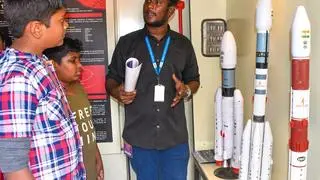The government’s announcement of the long-planned Deep Ocean Mission with allocation of Rs 4,000 crore for five years, has buoyed the programs of India’s ocean research organisations.
The Director of the National Institute of Ocean Technology, Chennai, Dr G Ananda Ramadass, feels that up till now, activities of the government-owned research institute were on project-mode, but now they will be on a Mission-mode. This means, working towards targets, both in terms of objectives and timelines.
Next month, NIOT is sending a home-made ‘crawler’ 6 km down into the Indian ocean, to see how it works.
“It is for a locomotion test,” Ramadass told BusinessLine .
When the machine is lowered to the floor, scientists onboard a ship above will see how it moves on the extremely soft, greasy ocean bed.
The machine moves on tracks, like a battle tank, but has buoys that keep pulling it up, so that it doesn’t get mired in the soft sands. The idea is to master ‘driving’ the vehicle on the ocean floor.
When scientists learn how to do this, they will be ready to onboard a spherical, 80mm-thick-walled, titanium capsule that can seat three people. At 6 km down, the capsule is crushed from all sides by the waters; it would feel a pressure of 600 bars, or, 600 times the atmospheric pressure that we feel on our bodies here.
The capsule is the ocean equivalent of the ‘crew module’ of space mission, Gaganyaan. It is informally the ‘samudrayaan’, and can detached from the crawler and nose around the ocean depths.
While the capsule is being developed in collaboration with ISRO, a mock version of it made of steel is being readied, to test many other subsystems such as power sources, life support systems, oxygen generator, carbon dioxide scrubber, connecters, cables, and thrusters. This clone will be downed to about 500 meters sometime later this year, in order to test the equipment.
India (like the US, Russia and China) is interested in the deep oceans because the ocean beds are littered with easy pickings of polymetallic nodules, the potato-like clumps that contain a variety of metals such as copper, nickel, cobalt and manganese.
NCPOR to hire AUVs
Meanwhile, another government body the National Centre for Polar and Ocean Research (NCPOR), headquartered in Goa, will also dive deep into the oceans.
M Ravichandran, Director, NCPOR, told BusinessLine that the Centre would hire “a swarm of AUV (autonomous underwater vehicles)” and send them down 4 km in another area of Indian ocean, east of Madagascar, to check out marine life and minerals hydrothermal vents— openings in the ocean floor out of which hot, mineral-rich water flows. Looking for these vents is like trying to find a needle in the ocean, Ravichandran said.
The International Seabed Authority, the Jamaica-based UN body, has permitted India to explore in an area of 10,000 sq km. NCPOR has identified a 100 sq km area here as being rich in hydrothermal vents.
The vent regions are rich in very unique life forms, that make their food from hydrogen sulphide—there is no sunlight there for photosynthesis, which sets-off the food cycle.
While there, NCPOR will also look for minerals.








Comments
Comments have to be in English, and in full sentences. They cannot be abusive or personal. Please abide by our community guidelines for posting your comments.
We have migrated to a new commenting platform. If you are already a registered user of TheHindu Businessline and logged in, you may continue to engage with our articles. If you do not have an account please register and login to post comments. Users can access their older comments by logging into their accounts on Vuukle.